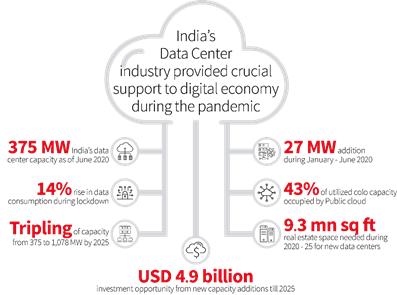Mumbai: India’s datacentre capacity is likely to grow from 375 MW in H1 2020 to 1,078 MW by 2025. The expected growth in India’s datacentre market is presenting a $ 4.9 billion investment opportunity, according to JLL.
According to JLL’s H1 2020 ‘re(Imagine) Datacentres Running India’s digital economy’ report, many factors are the driving force behind the expected increase in datacentre market capacity and investment.
That includes the impact of data protection laws, increased shift from captive to colocation (colo) datacentres and new technology implementations like 5G, edge computing and the internet of things (IoT) will drive sustained investor demand for this asset class over the next five years.

India’s datacentre market, according to Ramesh Nair, CEO & Country Head, India, JLL will outperform over the next five years, supported by a combination of growing digital economy, increased investor interest and stable long-term returns.
Colocations sites will further drive the growth in the sector, via, lower upfront costs, heightened data security, uninterrupted services and scalability will further, influence investors to reimagine the potential of India’s data canter space, observed Nair.
“The 703 MW expected capacity additions is translating to 9.3 million sq. ft. of space, which will open up greenfield investments for real estate developers and investors to fuel the future development of the sector,” said Nair.
India’s datacentre industry has provided immense boost to the digital economy during H1 2020. From an average 270 petabytes (PB) to 308 PB during week of March 22nd, a 14% rise in daily data consumption was observed during the lockdown.
There was a 12% rise in data consumption in Andhra Pradesh and Bihar, while there was a 7% increase in data consumption in Maharashtra which was the highest amongst other states.
In terms of total additional supply, there has been an increase of 8% in H1 2020, taking India’s total colocation capacity to 375 MW. H1 2020 also witnessed supply addition of 27 MW, 56% of the total addition seen in 2019 (48 MW). Mumbai continued its lead with addition of 19 MW, followed by Bangalore at 5 MW and Delhi NCR at 3 MW.
The transition to work from home arrangements during lockdown has made the, country’s datacentre industry as the backbone of the digital economy, according to According to Rachit Mohan, India Head – Datacentre Advisory JLL.
“And ensured a level of business continuity and sustained large portions of the country’s education system. Given shifts in the economy, we will continue to see data consumption increase manifold for the foreseeable future,” said Mohan.
Several industries’ dependence on digital infrastructure has partially helped mitigate the lockdown impact with IT/ITeS, banking and financial services, e-commerce, capital markets, social media and education remained operational.
“Mumbai is expected to see highest capacity addition. It continues to be the preferred choice for large cloud players because of its infrastructure advantage,” said Dr Samantak Das, Chief Economist and Head of Research & REIS, JLL India.
“Chennai is also proving an attractive destination due to its advantages of submarine cable landing stations and low development costs,” added Das.

